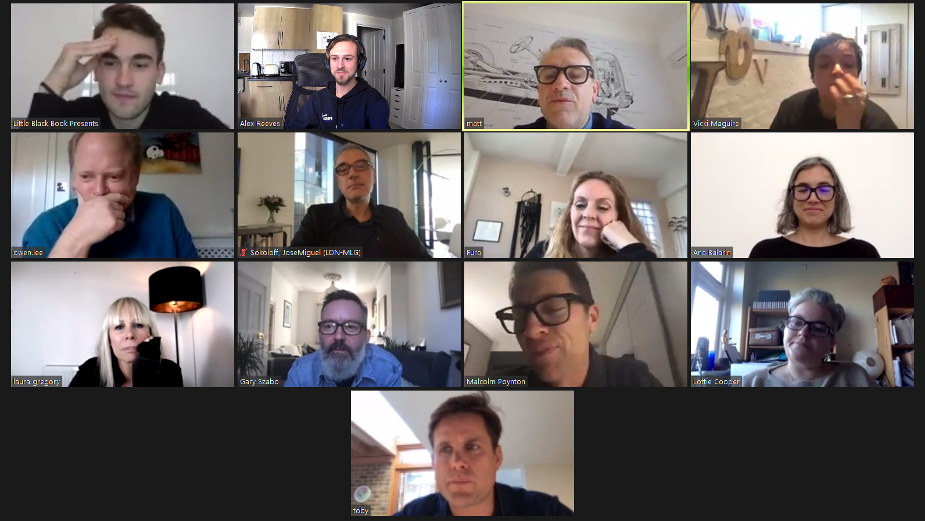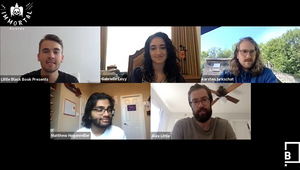
Inside the Jury Zoom: Selecting the Immortal Awards’ European Quartet of Quality

29 shortlisted pieces of creative work passed before the discerning eyes of the Immortal Awards’ European regional jury. Only four finalists emerged. The last of 2020’s Immortal Awards regional heats convened last week and the judges are hoping that their quartet of European creative selections will represent the continent as the work proceeds to the final global jury at the end of November.
This was another remote judging session in this year’s new format of regional judging, designed to ensure that brilliant local ideas get the chance to shine on a global stage.
The assembled judges included Malcolm Poynton, global chief creative officer of Cheil Worldwide, Jose Miguel Sokoloff, global president of MullenLowe Group Creative Council and chief creative officer of MullenLowe Group UK, Ana Balarin, executive creative director of Mother London, Vicki Maguire, chief creative officer of Havas London, Toby Allen, deputy executive creative director of AMV BBDO, Fura Johannesdotir, chief design officer of HUGE, Owen Lee, chief creative officer of FCB Inferno, Laura Gregory, founder of Great Guns, Lottie Cooper, managing director, integrated advertising of Framestore, and Gary Szabo, chief creative officer of Tag.
The chance to take the time to hang out on Zoom wasn’t taken for granted by the jury. “What a really great way to spend a day! Hanging out with my peers just looking at and talking about great work,” says Gary. “It’s so rewarding to spend a day in the company of such brilliant and passionate people. To be part of something that is just focused on people trying to be the best that they can be was a real tonic, especially at the moment.”
Malcolm, who was quarantined and unable to go outside, particularly appreciated the chance for human connection, especially with the task of focusing on the industry he loves. “The Europe jury room was a bunch of great people with a real focus on what work on the list really mattered,” he says. “Mattered in the cultural and commercial context today as much how much it will matter as a reference point in years to come. It wasn’t just a discussion about Gold, Silver, Bronze, it’s bigger than that. It’s about ‘immortal’. And given that, the craft and the details got a heck of a lot of attention too.”
It wasn’t just a collection of people at the top of their game, but people from different parts of the game too. “I loved that the jury was pulled from varying disciplines,” says Vicki. “It elevates the process and ensures that each piece is judged as a whole. From idea to cinematography, every aspect of our chosen work came under the microscope and was discussed by judges that know their respective shit.”
Beyond that, Vicki appreciated the Immortal Awards structure that protects against big agencies winning titles through the sheer quantity of work they enter in countless categories: “You have no idea how refreshing it is, as a juror and as a creative head, to have agencies think about the number of work they submit. The best of the best. You don’t get points for the number you enter. There's a purity and almost respect about that.
Reflecting on the new format of regional heats before the finalists go through to a global jury seemed to work well, from the judges’ perspectives. “We could focus on how well the work stood up on its own, without worrying about relevance to different audiences,” says Lottie.
“It has long been argued that work that is of specific cultural relevance doesn’t always get a fair showing on award juries and there is truth in that,” says Owen. “I also think it is interesting for us as an industry to see how the work differs from region to region, though I am sure, only the work that crosses all borders will be voted Immortal.”
Fura agreed that while it was helpful to see regional nuance, the best of the best will be universal. “At the end of the day - whatever rises to the top is going to be work that breaks through borders and works for a global context. Immortal work that connects us all.”
Malcolm feels that regional juries will make for a more diverse global round, ultimately and he can’t wait to see what ends up in coming out of that later this month. “It’ll be a case of the best from Europe vs US vs LATAM vs Asia Pacific vs MEA in the final judging. That’s sure to make for some interesting discussion.”
All the jurors agreed that they were a strict bunch. “Perspective and passion ran high in the jury room. Projects were discussed with rigour at key points during the day,” says Laura.
Jose Miguel thought the high standards of the jury were the most interesting part of the conversation. “Only the most powerful work got through without any other consideration apart from the fact that it had done something to move advertising forward. I think this is down to the nature of the award themselves, the fact that they have been established to recognise work that should never lose its validity and award work that you should never forget.”
The concept of immortality framed the discussion throughout. As Fura puts it, “it needs to be work that stands the test of time, work people are going to remember and reference in the future. You are forced to put on a different hat, push harder and be more brutal - and as a result the conversation in the jury room changes.”
Toby agrees. “You’re not talking about what is the best work in any particular year, you’re talking about the what work will be remembered for years to come,” he says.
What is good, very good or even great was a debate that Owen felt had no place in this jury. Rather, the jury discussed which pieces of work they really believed they would still be talking about and would revisit in five or 10 years from now. “We questioned whether work was derivative of something we had seen before, was it bold, was it fresh, will it stand the test of time?”
2020 hasn’t been the easiest year to make work like that. As Owen says, “much of the industry’s ability to realise great ideas has been hampered.” But the judging reminded him of Europe’s strengths as a region in the creative market. “We remain very strong in film and storytelling. I think it’s telling that even in a year dominated by Covid, a lot of the work that didn’t make the cut was still very good thinking.”
Malcolm was also interested to see the focus on film that the work in this region demonstrated. “Perhaps it’s a reflection of the uncertain mood in Europe where issues like the refugee crisis and Brexit have given rise to a general sense of unease,” he says. “Film tends to get under our skin and pull heart strings quicker at times like this. So, perhaps that explains why Europe is currently more drawn to film. Amazing though, at a time where we are seeing such incredible innovation in mobile and digital, we’re not seeing more brands doing amazing things with it in Europe.”
Linked to that strength in film, Malcolm’s reaction to the work the jury put through was visceral: “Funny, artful, bloody, revolting, racist, shocking – from mouldy burgers to rapping teapots, and animated wombs to Riz Ahmed’s soliloquy, I love ideas that move us. And the common thing between these four very diverse pieces we put through was that each moved me. In different ways of course, but they moved me in ways that make me remember them.”
Riz Ahmed’s The Last Goodbye left several of the jury stuck in its emotional wake for some time, while IKEA’s Silence the Critics was praised for how it changed the game in UK Christmas ads. “It’s audacious, the perfect direction for a brand that sets out to entertain and change perception time and time again,” says Laura. Toby says it “broke the mould of Christmas advertising in a totally ‘fresh and clean’ way. Given the cultural importance of Christmas ads in the UK, it was a bold move.” And Vicki admitted it “never fails to blow me away. I believe great work is a combination of creative, culture and context. This piece nails it.”
Also breaking the mould by using actual mould to market fast food, Burger King’s Moldy Whopper was also praised. “Bravery remains the marker of a great idea. For Burger King to allow people seeing their product literally rot in front of their eyes is simple, bold and iconic,” says Owen. Jose Miguel says “Moldy Whopper is one of the bravest things that has been done in advertising in a long time.”
The four finalists were unanimously deserving, the jury agreed. “It felt good. Everyone had a say, everyone had a valuable contribution and argument for the work that went through,” says Laura.
“It’s incredibly powerful work,” says Jose Miguel. “The four finalists are all examples of extremely brave work that approach problems in a very creative and interesting way and are pushing the boundaries of our industry to do something that has never been done before.”
Gary found it personally encouraging: “With everything that’s going on in the world it was great to remember why I wanted to work in this industry in the first place!”
Soaking this all up, the judges came away with a strong sense of the emotional impact, audacious bravery and film craft that European advertising is so adept at. As Toby sums it up: “Each region tends to have different strengths, shaped by industry skills and the media landscape. I can’t wait to see the Immortal ‘world championship’ where the best in each region go up against each other.”
Check out the Europe finalists here.













